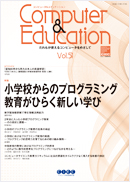Volume 51
Displaying 1-18 of 18 articles from this issue
- |<
- <
- 1
- >
- >|
Special Reports on "Programming Education in Elementary School Opening the Door to New Learning "
-
2021Volume 51 Pages 14-19
Published: December 01, 2021
Released on J-STAGE: June 02, 2022
Download PDF (759K) -
2021Volume 51 Pages 20-26
Published: December 01, 2021
Released on J-STAGE: June 02, 2022
Download PDF (536K) -
2021Volume 51 Pages 27-32
Published: December 01, 2021
Released on J-STAGE: June 02, 2022
Download PDF (640K) -
2021Volume 51 Pages 33-38
Published: December 01, 2021
Released on J-STAGE: June 02, 2022
Download PDF (470K) -
2021Volume 51 Pages 39-45
Published: December 01, 2021
Released on J-STAGE: June 02, 2022
Download PDF (503K) -
2021Volume 51 Pages 46-51
Published: December 01, 2021
Released on J-STAGE: June 02, 2022
Download PDF (443K)
Research Articles
-
2021Volume 51 Pages 52-57
Published: December 01, 2021
Released on J-STAGE: June 02, 2022
Download PDF (564K)
Pedagogical Articles
-
2021Volume 51 Pages 58-63
Published: December 01, 2021
Released on J-STAGE: June 02, 2022
Download PDF (432K) -
2021Volume 51 Pages 64-69
Published: December 01, 2021
Released on J-STAGE: June 02, 2022
Download PDF (414K) -
2021Volume 51 Pages 70-74
Published: December 01, 2021
Released on J-STAGE: June 02, 2022
Download PDF (494K) -
2021Volume 51 Pages 75-80
Published: December 01, 2021
Released on J-STAGE: June 02, 2022
Download PDF (497K) -
2021Volume 51 Pages 81-86
Published: December 01, 2021
Released on J-STAGE: June 02, 2022
Download PDF (439K) -
2021Volume 51 Pages 87-92
Published: December 01, 2021
Released on J-STAGE: June 02, 2022
Download PDF (450K)
Practical Reports
-
2021Volume 51 Pages 93-96
Published: December 01, 2021
Released on J-STAGE: June 02, 2022
Download PDF (402K) -
2021Volume 51 Pages 97-100
Published: December 01, 2021
Released on J-STAGE: June 02, 2022
Download PDF (443K)
Software Review
-
2021Volume 51 Pages 101-102
Published: December 01, 2021
Released on J-STAGE: June 02, 2022
Download PDF (292K)
Errata
-
2021Volume 51 Pages 131
Published: December 01, 2021
Released on J-STAGE: December 01, 2021
Download PDF (90K)
Editorial Notes
-
2021Volume 51 Pages 132
Published: December 01, 2021
Released on J-STAGE: June 02, 2022
Download PDF (246K)
- |<
- <
- 1
- >
- >|
